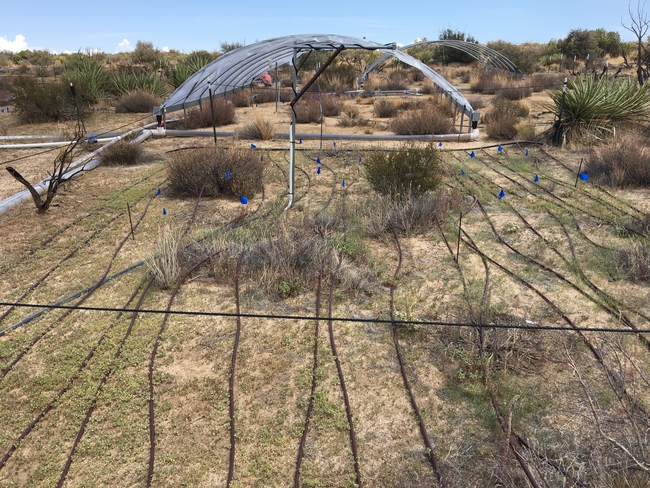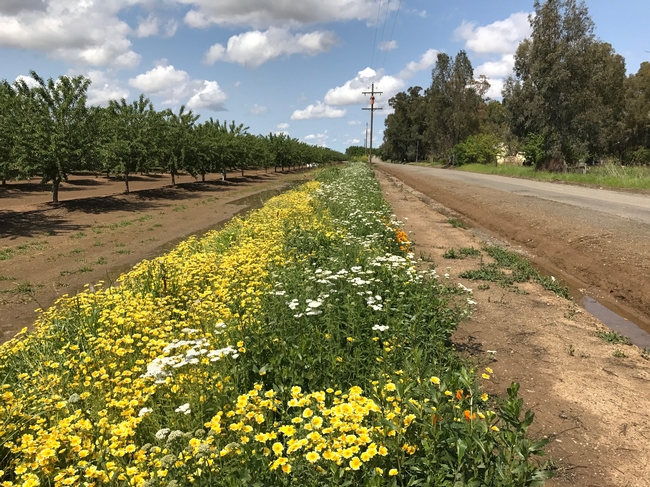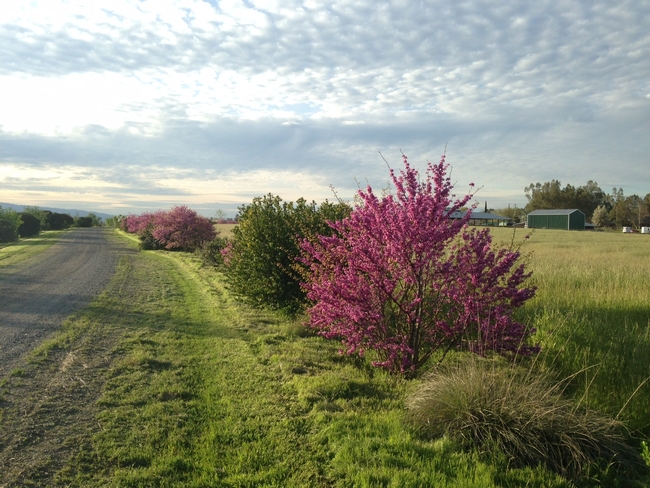Posts Tagged: wildflowers
With dwindling water supplies, the timing of rainfall matters
How to help plants in drought-stricken states
A new UC Riverside study shows it's not how much extra water you give your plants, but when you give it that counts.
This is especially true near Palm Springs, where the research team created artificial rainfall to examine the effects on plants over the course of two years. This region has both winter and summer growing seasons, both of which are increasingly impacted by drought and, occasionally, extreme rain events.
Normally, some desert wildflowers and grasses begin growing in December, and are dead by June. A second community of plants sprouts in July and flowers in August. These include the wildflowers that make for an extremely popular tourist attraction in “super bloom” years.
“We wanted to understand whether one season is more sensitive to climate change than another,” said Marko Spasojevic, UCR plant ecologist and lead study author. “If we see an increase or decrease in summer rains, or winter rains, how does that affect the ecosystem?”
The team observed that in summer, plants grow more when given extra water, in addition to any natural rainfall. However, the same was not true in winter.
“Essentially, adding water in summer gets us more bang for our buck,” Spasojevic said.
Their findings are described in a paper published in the University of California journal Elementa.
Over the course of the study, the team observed 24 plots of land at the Boyd Deep Canyon Desert Research Center, in the Palm Desert area. Some of the plots got whatever rain naturally fell. Others were covered and allowed to receive rain only in one season. A third group of plots received additional collected rainwater.
While adding water in summer resulted in higher plant biomass, it generally did not increase the diversity of plants that grew, the researchers noted. Decreasing rainfall, in contrast, had negative effects on plants across both summer and winter, but may lead to some increased growth in the following off-seasons.
Implications of the work extend beyond learning when additional water resources might be applied simply to help plants grow. Whole communities of animals depend on these plants. They are critical for pollinators such as bees and butterflies, and they play a big role in controlling erosion and movement of soils by wind.
“Studies like this one are critical for understanding the complex effects of climate change to dryland ecosystems,” said Darrel Jenerette, UCR landscape ecologist and study co-author.
Desert plants also play an important role in removing carbon dioxide and nitrogen from the atmosphere to use as fuel for growth. Microbes that live in the soil can use the carbon and nitrogen released by plant roots, then send it back into the atmosphere where it can affect the climate.
“Drylands cover roughly a third of the land surface, so even small changes in the way they take in and emit carbon or nitrogen could have a big impact on our atmosphere,” said Peter Homyak, UCR environmental scientist and study co-author.
As the team continues this research over the next few years, they expect to see changes in soil carbon and nitrogen cycling, given that plants are already being affected by changes in seasonal rainfall, as this study shows.
“Can changes in precipitation patterns alter the feedback between plants and microbes, destabilizing the carbon locked in soils and sending more of it into the atmosphere? We are working on figuring that out,” Homyak said.
Editor's note: Jenerette and Homyak are affiliated with University of California Agriculture and Natural Resources through UC Riverside's Agricultural Experiment Station.
Super blooms in the Central Valley: Why it’s not just about the color
Have you seen the blaze of super blooms popping up alongside orchards and field crops in our rich agricultural Central Valley? The corridors of poppies, tidy tips, yarrow, baby blue eyes, and redbud planted by farmers, dazzle us with color, but they serve a purpose, too.
The flowers provide nectar and pollen for the pollinators, including honey bees, bumble bees and carpenter bees. Look beyond the buzz, and you'll see other beneficial insects, such as lady beetles (ladybugs) and their larvae devouring aphids, and tiny parasitoid wasps preying on stinkbugs and armyworms. They're (unpaid) pest control agents at work.
Farmers are taking notice. Knowing that most beneficial insects rely on floral resources to survive and reproduce, they're bordering their field crops with strips of flowering plants. In addition to gaining pollination and pest control services, they're gaining financial benefits. University of California researchers documented that pest control and pollination benefits will help pay the cost of a 1,000-foot-long-flowering hedge planting within 7 to 16 years. Their research, Pest Control and Pollination Cost-Benefit Analysis of Hedgerow Restoration in a Simplified Agricultural Landscape, was published last year in the Journal of Economic Entomology.
Other benefits of field edge habitat plantings can include weed exclusion, air quality improvement, erosion reduction, wind protection, shade, and wildlife habitat.
What plants are best to attract beneficial insects to farms and gardens? The UC Statewide Integrated Pest Management Program (UC IPM) has just published a list of insectary plants on its website. The list includes native California perennial flowering shrubs and wildflowers suited for field-edge plantings.
UC IPM defines insectary plants as “those grown to attract, feed, and shelter insect parasites (parasitoids) and predators to enhance biological pest control. Insectary plants provide nectar and pollen for adult natural enemies to consume. Even if pests are abundant, certain natural enemies may be less abundant, shorter-lived, or produce fewer offspring unless nectar and pollen resources are available. Insectary plants can also host alternate prey that will feed the natural enemies and keep them abundant locally.”
Are you concerned about rodents and food safety issues from hedgerows plantings? Not to worry. A recent study by UC Agriculture and Natural Resources (UC ANR) researchers found minimal adverse influence on larger agricultural landscapes. A bonus: Migratory songbirds, like goldfinches, often seek out the seeds from the flowering plants in the hedgerows and offer their own display of color. What about weeds? Yes, they can be problematic. Be sure they're well-controlled before planting wildflowers; think soil solarization and herbicides.
Another UC ANR-associated study, Determinants of Field Edge Habitat Restoration on Farms in California's Sacramento Valley, published this year in the Journal of Environmental Management, found that landowners and farmers familiar with the benefits were more likely to adopt these small-scale habitat restoration plantings on their farms. Also important is technical support from agencies such as the USDA, UC Cooperative Extension Service, and the Xerces Society for Invertebrate Conservation, and the sharing of information from farmer-to-farmer and neighbor-to-neighbor.
Something else we can all do: Share your photos of field-edge habitat plantings and your observations on social media. They tell an important story and can inspire landowners to diversify farmlands. This will help drive home the point that providing flowers for beneficial insects, including bees and natural enemies, will build resilience in our farming systems. Natural pollination and pest control services help counter the disastrous effects of colony collapse disorder and other honey bee maladies, and pesticide resistance.
And it's a counter-punch of color.
How wildflower plantings on farms benefit bees and crop pollination
Bloom where you're planted.
That old adage takes on more meaning when you plant wildflower strips on your farm. Wildflowers add resilience to our farming systems by providing bees with habitat and food - pollen and nectar. And they're not just for honey bees. Many native bees, such as bumble bees and blue orchard bees, are important crop pollinators. Currently about a third of our crops benefit from bee pollination. This includes vegetables, fruit and nuts, as well as crops grown for seed production, including sunflower, melon, and carrot.
Farmers primarily rely on honey bees for crop pollination; generally two colonies per acre are needed. Honey bees are efficient pollinators, but with colony collapse and increasing colony losses, we must diversify our farming systems so we don't rely solely on honey bees.
Some important native bee crop pollinators include bumble bees, sunflower bees, squash bees, mason bees (blue orchard bees, which pollinate almonds, are mason bees) and leafcutter bees.
The benefits of native bees? Generally they forage on flowers earlier in the day than honey bees do, they tolerate more wind and cooler temperatures and often they're more efficient at gathering and moving pollen from one flower to another. Native bees also prompt honey bees to disperse more, resulting in more pollinator efficiency. All this is important for good pollination and crop production, especially for crops like almonds that bloom in late winter when the weather is more unpredictable.
Many native bees, including squash bees, nest in the soil, generally excavating chambers about 12 inches deep, where they pack cells with pollen for their young. Bumble bees often occupy vacated rodent holes. Leafcutter bees nest in woody cavities, often taking advantage of old beetle galleries. Discing and land clearing removes their nesting sites and potential food sources, but if you add wildflower plantings and hedgerows of flowering shrubs on your farm, that brings them back. Farms with strips of flowers along field edges have higher numbers of native bees than those that do not. Honey bees also benefit from better nutrition from flowers, strengthening their resiliency to pests, diseases, and pesticides.
A recent study, Pest Control and Pollination Cost–Benefit Analysis of Hedgerow Restoration in a Simplified Agricultural Landscape, published by UC Agriculture and Natural Resources (UC ANR) and UC Berkeley, describes the economic value of these plantings. Generally, a $4,000 investment to plant a 1,000-foot hedgerow of native California plants, takes about seven years to pay off from enhanced pest control and pollination services from natural enemies and bees (where honey bees are limiting). If cost-share funding is available from the USDA, this will reduce the investment cost for the restoration and time on returns.
Although habitat plantings are definitely beneficial, some farmers have expressed concern that these plantings will bring in more pests, including rodents, birds and weeds. However, current UC ANR studies show strips of flowers on field edges export beneficial insects into adjacent crops for enhanced pest control. The wildflower strips are too small to support large numbers of rodents or flocking birds that can damage crops (with the possible exception of ground squirrels and cottontail rabbits), and weeds requiring management are present regardless of field edge habitat.
Water? Although it's hot and dry out right now, many wildflowers do not need summer water. This includes Bolander's sunflower (great for songbirds like goldfinches, but the seeds should not be included in row crop mixes as they will cross-pollinate with our hybrid sunflower seeds), milkweed (great for monarch butterflies), vinegarweed, tarweed, gumplant, turkey mullein (doves love these seeds), and summer lupine. Bees, including natives and honey bees, thrive on these hardy flowers, especially now that the growing season is ending, and few crops are blooming.
Look for more information on wildflower and hedgerow plantings on the Hedgerow Hub website, , the Xerces Society website, and UC Davis fact sheet Habitat for bees and beneficials.
Networking is important too. A recent UC ANR survey showed that networking among growers, landowners, and conservation agencies is crucial in the adoption and implementation of new ideas, such as wildflower plantings.
Bottom line: Wildflower strips can ensure a healthy, sustainable food supply for crops that rely on bee pollination. “Bloom where you're planted” equals “Reap what you sow.”
Drought is impacting California’s wildflowers
Native wildflowers in California are losing species diversity after multiple years of drier winters, according to a study from the University of California, Davis, which provides the first direct evidence of climate change impacts in the state's grassland communities.
The study, covered in TIME, LA Times, and elsewhere, was published in the journal Proceedings of the National Academy of Sciences. It's based on 15 years of monitoring about 80 sampling plots at McLaughlin Reserve, part of UC Davis' Natural Reserve System.
"Our study shows that 15 years of warmer and drier winters are creating a direct loss of native wildflowers in some of California's grasslands,” said lead author Susan Harrison, a professor in the Department of Environmental Science and Policy and a member of UC Agriculture and Natural Resources' Conservation Biology workgroup. “Such diversity losses may foreshadow larger-scale extinctions, especially in regions that are becoming increasingly dry.”
The researchers confirmed that drought-intolerant species suffered the worst declines.
Global trend
Similar trends have been found in other Mediterranean environments, such as those of southern Europe, bolstering the case for increased climate change awareness in the world's semi-arid regions.
Taken together with climate change predictions, the future grassland communities of California are expected to be less productive, provide less nutrition to herbivores, and become more vulnerable to invasion by exotic species, the study said.
The researchers expect these negative to cascade up through the food web—affecting insects, seed-eating rodents, birds, deer and domesticated species like cattle, all of which rely on grasslands for food.
Rescue effect may be too late
Grasses and wildflowers may be able to withstand the current drying period through their extensive seed banks, which can lie dormant for decades waiting for the right conditions to germinate.
However, California's drought is expected to intensify in the coming decades, so this rescue effect may end up being too late for some species.
Author: Kat Kerlin
Planter boxes and Wildflowers
When my neighbor removed a 30 plus year old Mulberry tree (Morus spp.), I suddenly had sun in a corner of my yard. This motivated me to remove two shrubs and clean up that corner. Because of the tree’s size, I had a lot of big roots that had invaded my yard and would be very costly to have them completely removed. So instead, I decided to have planter boxes made and planted them with, Gaura, Gerber daisy (Gerbera jamesonii), bee balm (Mondarda spp.), dwarf lavender (Lavendula spp.) and Geum, cone flower plants that bees, butterflies and hummingbirds would be attracted to. But I still had the spaces behind the boxes to deal with. The soil was scratched up and a packet of wildflowers seeds were scattered behind the boxes, then a light cover of potting soil was put on top of the seeds. In the mix were nasturtiums, clarkia, and Bells of Ireland.
Spring came and so did the nasturtiums (Tropaealum majus) which really filled in the space with blossoms of orange, pale yellow with touches of red and bright yellow with red spots, and a few white ones here and there. There was also Clarkia, Onagraceae, one of the plants blossom is bright pink, and the other is rose with pink strips. Bells of Ireland, Moluccella laevis pushed their way thru the nasturtium’s to stand tall with their bright green whorls. A Rocket Larkspur (Delphinium ajacis). in a bright blue-purple color.
So now I have color in a part of my yard that once was shade and a forgotten corner. What a difference, it even makes the yard appear larger.

Nasturtium (photos by Betty Victor)

Blue of rocket larkspur, the green of the Bells of Ireland (see right) and the pink Clarkia.








